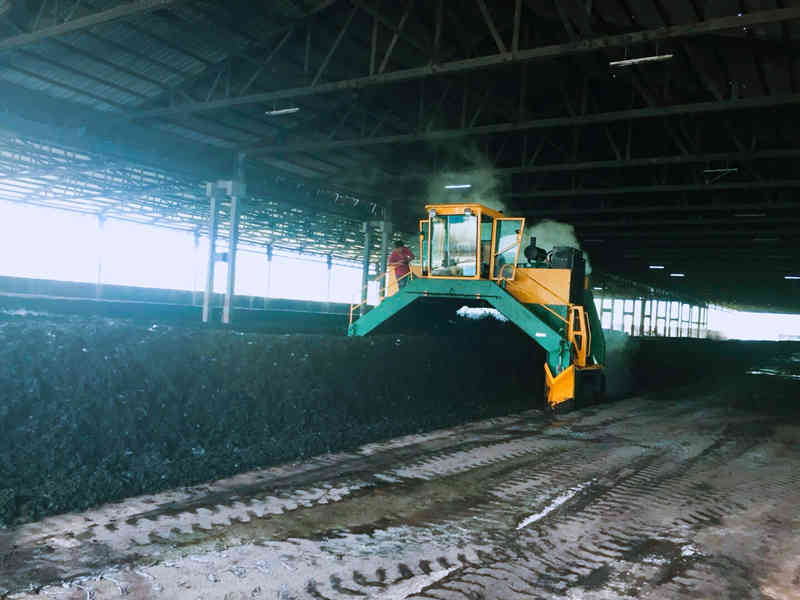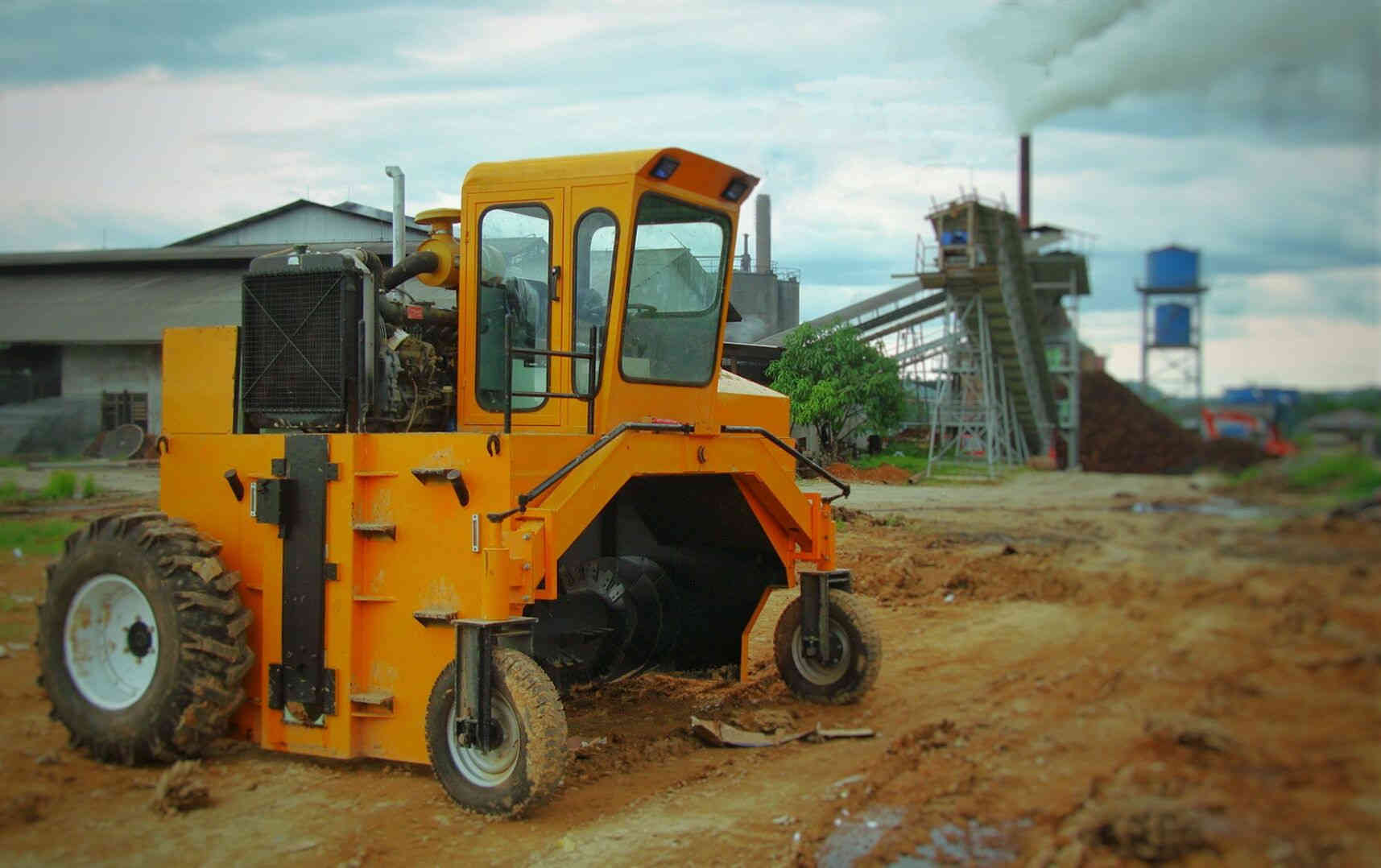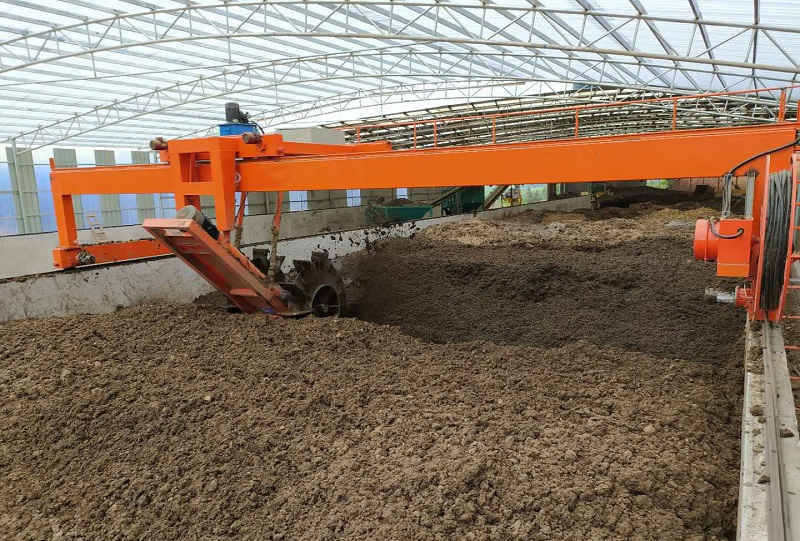The self-propelled compost turner can give full play to its stirring function. In order to meet the requirements of moisture, pH, etc. in the fermentation of raw materials, some auxiliary agents need to be added. The permeability of the raw materials makes the raw materials fluffy and elastic, and at the same time absorbs a large amount of air, which increases the temperature of the compost windrow pile. An alternating state is beneficial to the growth and reproduction of microbial bacteria. In addition, a certain amount of water will be generated in the process of organic fertilizer fermentation, and the production water requirement of finished organic fertilizer is that the water content should be below 20%, so the use of compost turning machine can reduce the water and speed up the evaporation of water.
When making organic fertilizer, the number of bacteria is artificially increased, so the decomposing time of compost is greatly reduced. Fertilizer fermentation is generally 7-10 days, which can make organic fertilizer reach the standard of high-quality organic fertilizer. Kill plant pathogenic bacteria, insect eggs, weed seeds, and other substances. In the later cooling period, the microorganisms will humus the organic matter, and in the process, produce a large number of metabolites that are beneficial to plant growth and absorption.
The self-propelled stacker is mainly distinguished from the walking mode: crawler type, wheel type, and Orbital type:
1. Crawler-type Windrow Turner
It also known as a crawler hydraulic compost turning machine, is a kind of ground compost turner. The machine has the characteristics of compact design, simple operation, and saving workspace.
Working principle: The crawler compost turner adopts a full hydraulic operating system, a lever-type steering wheel operation, and crawler-type walking, and cooperates with a high-horsepower diesel engine. The crawler-type stacker adopts the design of the overall lifting and lowering of the frame, which can raise and lower the height of the frame when the worksite is changed and the height of the stack needs to be changed, which makes the operation more convenient. Since the crawler-type pile turner adopts a full hydraulic power design, there is basically no mechanical wear, the failure rate is very low, and there is little maintenance.
Scope of application: Both the crawler-type dumper and the tire-type dumper belong to the ground dumper type. The crawler-type dumper has a stronger dumping capacity and larger output and is generally suitable for large-scale organic fertilizer plants.
2. Wheel-type Compost Turner
TAGRM wheel-type compost turner M2300
The wheel-type compost turner is belongs to the same type of ground composting machine as the crawler-type.
Working principle: It adopts a four-wheel walking design, which can turn forward and backward. During the driving, the whole vehicle rides on the pre-stacked long strip of fertilizer base, and the auger under the rack churns, fluffs, and moves the fertilizer base raw materials, and after the vehicle passes, it becomes a new strip-shaped pile. The machine can operate in the open outdoor field or in the workshop greenhouse. The wheel-type compost turner is one of the most economical types of dumpers. It is generally equipped with a canopy, and the cab can also be customized according to customer needs.
Scope of application: This wheel-type pile turner is more portable and flexible, and is suitable for various organic fertilizer production sites. However, due to its limited processing capacity, it is more used in small and medium-sized organic fertilizer plants and farms to processing manure.
The main advantages of the self-propelled turner compared with other machines are: that it is suitable for the turning and fermentation of a large number of organic fertilizer raw materials in an environment with a large production site. Adopting full hydraulic power design, there is basically no mechanical wear, low failure rate, and little maintenance; greatly improving work efficiency and use efficiency
3. Orbital-type Compost Turner
The orbital-type compost turning machine is also known as the trough-type turner. As the name suggests, the orbital-type turner needs to follow the pre-built running track during the working process. The equipment is composed of main components such as a transmission device, lifting device, walking device, turning device, displacement vehicle, and so on.
Working principle: The motor directly transmits the power to the cycloid reducer through the sprocket to the turning drum. The stirring blades on the drum are spirally distributed, which can turn the materials in the fermentation tank and move them to a position 0.7-1m away. to achieve the effect of fast turning speed and uniform stirring, so as to achieve full contact between the material and the air, and make the fermentation effect of the material better.
Scope of application: Orbital turners are generally used in large-scale organic fertilizer production plants with limited production sites. This compact site planning and design not only saves the fermentation site of organic fertilizer raw materials but also facilitates turnover and continuous granulation with subsequent granulation production lines. Production.
Summary: The above three types of turners are all suitable for turning and fermenting organic fertilizer viscous materials such as livestock and poultry manure, sludge, distiller grains, furfural, etc.
Based on the introduction of the above equipment, the main advantages of the crawler-type composting machine compared with other composting machines are as follows: it is suitable for turning and fermenting a large number of organic fertilizer raw materials in an environment with a large production site. Adopting full hydraulic power design, there is basically no mechanical wear, low failure rate, and little maintenance; greatly improving work efficiency and use efficiency.
If you have any inquiries, please contact our email: sale@tagrm.com, or WhatsApp number: +86 13822531567.
Post time: May-31-2022



